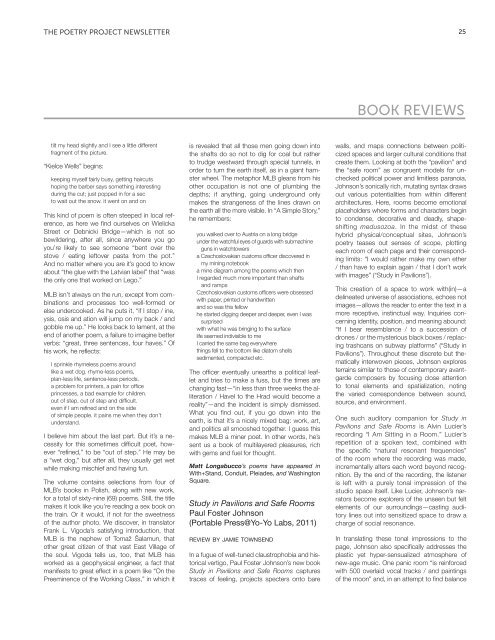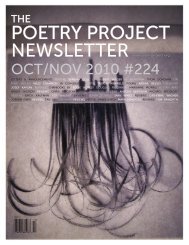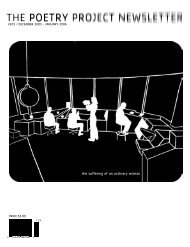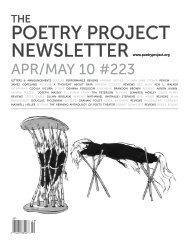24 APR/MAY 11 #227BOOK REVIEWSA Place in the SunLewis Warsh(Spuyten Duyvil, 2010)review by stephanie dickinson“Caress the detail, the divine detail.”—Vladimir NabokovLewis Warsh’s elegant A Place in the Sun offersup the treats of postmodernism, with its blurringof fiction/reality, its multiple and shifting pointsof view, and its divine detail of Nabokov andrich characterization and clarity of Tolstoy. <strong>The</strong>progression is nonlinear, the writing crystalline,each sentence and scene immediately understandableyet sensuous, so that the effect feelsphantasmagoric. <strong>The</strong> writing is water that flows(seemingly) effortlessly. Call it noir or fin de sièclewith its connotations of decadence and sensationalism,or post-post modern: the authorseems attracted to the ménage à trois and allthe complications of the eternal triangle.Like the 1951 movie A Place in the Sun thenovel takes its name from, starring MontgomeryCliff and Elizabeth Taylor, or <strong>The</strong>odore Dreiser’sAn American Tragedy, the most naturalistic andchronological of books on which the movie isbased, sex underlies the whole. Warsh’s novelopens in a film noir moment. “<strong>The</strong> two Russianwomen were in the kitchen of their apartmentwhen Eddie Perez came in through the windowwith a gun.” He ties Marina to a chair and takesIrene into the bedroom where he rapes andmurders her. We don’t see what happens onthe other side of the door. Eddie is killed by thepolice. <strong>The</strong> cop in charge is Harry Cray, whorescues Marina and later becomes her lover.From this primal scene we are flooded with akaleidoscope of the recent past. “It was Marina,of course, after it was over, who filled in theblanks.” Marina, newly immigrated to New YorkCity, settles in a basement apartment owned byher uncle, who expects sexual favors. Ivan, asmall-time Russian thug, then rescues her fromthe uncle. Marina seems to tolerate him best afterhe is sent to prison. Her doomed lover Irenefinally joins her; the more sexually experiencedIrene is poignant with a past: her dead baby Sashais the fruit of her secret relationship with anolder disabled lover, “the man with scars.” Weshift into first person; the “I” is a non-Russianwoman and a friend of Marina’s, “invited to amillion parties, introduced to a million men.”<strong>The</strong> “I” also has the name of Harry Cray in heraddress book.<strong>The</strong> stories pool out. <strong>The</strong>y are served upobliquely, surprisingly, with new eyes andmouths. <strong>The</strong> book is divided into six sections,and while there is a formality of separation, theywash into each other. Russian mobsters segueinto the tabloid world of Montgomery Cliff andElizabeth Taylor, to whom Warsh dedicates thenovel. <strong>The</strong>se riveting chapters explore the innerand outer, the person and persona, the virtualand actual. Often the cinematic identity seemsthe more real. Montgomery Cliff is voted by theBarbizon Models of 1948 as the most eligiblebachelor, the same year he’s arrested for pickingup boys in Times Square. He’s at partiesswallowing pills by the handful. <strong>The</strong> well-readMonty cruises, trolling the night. <strong>The</strong> elixir offame all want to drink turns out to be the greatpoison. Those so exalted become alcoholics,drug addicts—simultaneously tormented andtormenting. Elizabeth Taylor is a whining, accident-pronecheat. “She is pornographic,” herhusband Eddie Fisher says. “Being ElizabethTaylor’s lover is a full time job.”<strong>The</strong>odore Dreiser presses his face against arestaurant’s window glass, full of self-contempt.“Couples mainly: the man lifts his glass and proposesa toast while the woman (twenty yearsyounger, at least) tosses her hair out and raisesher bare shoulders like a swan, a statue of aswan, as inert and dumb as any statue mightbe.” Dreiser fantasizes about the swan womanand compares her to his frigid fiancé Sara, whohe calls “Jug.” Woven in are gems of knowledge,that Bertolt Brecht’s lovers wrote majorportions of his plays and “instead of loving themmore, he jilted them.”In an age where sexuality has become commodity,packaged between the force-feed ofpornography (credit cards at the ready) andmagazines haranguing readers with insipid tipsfor better sex, the danger in writing about copulationis that you may bore the reader with a desexedsex, un-erotic, sterile poppycock. Warshwrites sex on the edge of death. He writes pleasure;he smacks characters against each otherwho shiver and spark. This power, both destructiveand creative, unites much of the text.Novels as sophisticated as this one usuallymake reading them feel a bit like work. A bookonly the literati could love. Not this one. It is apage-turner, a smooth compulsive read. <strong>The</strong>writer/poet caresses the detail and the writer/novelist seduces us with narratives. A Place inthe Sun is not for the likes of Warsh’s characters,those self-destructive, impulsive, physicallyattractive people, or in the case of ElizabethTaylor, “the most beautiful woman in the world.”A place in the dark better suits them.Stephanie Dickinson is the author of Half Girl,a novel, as well as the collection of stories, Roadof Five Churches.69MLB (Miłosz Biedrzycki)Translated by Frank L. Vigoda(Zephyr Press, 2010)review by matt longabuccoAt a reading the other night, Ariana Reines toldthe audience she was going to read one of thelast few poems she’d written before “giving upthe East Village style.” If that was meant as aprovocation, it worked as one, because peoplelike the East Village style (and it’s fun to refusepeople what they like). I take her use of theterm to refer to that kind of poem whose formis based on the experience of walking downthe street on something. <strong>The</strong> resulting poembeing part walker, part street, part the something(the something is always language, in theend). Loose, fizzy, interruptible, attitudinal stuff,though refreshingly not self-aggrandizing becauseit’s too drenched in a native New Yorker’ssense of scale: you’re never going to be LouReed, even if he’s walked the same streets.Funny to think that in this style the East Villagehas found its very own export. Polish poet MLB(Miłosz Biedrzycki) brings it back to us alive andfresh, though transformed in telling ways: stillurbane but somehow earthier, dingier but morewry. Early in this volume a persona brags, “I wasthe first one in Poland / to write like O’Hara.”And MLB does seem to bounce around Krakowin ways that the great city poet might recognize:Krakow, 1/29/91, hey! what’snew, nothing much here but maybesomething’s new with youAnd in a poem entitled “Virtual Reality”:I walk & marvel at how realistic it isI feel the pressure on my shoe exactlywhere the sole of my foot meets the sidewalk
THE POETRY PROJECT NEWSLETTER25BOOK REVIEWStilt my head slightly and I see a little differentfragment of the picture.“Kielce Wells” begins:keeping myself fairly busy, getting haircutshoping the barber says something interestingduring the cut; just popped in for a secto wait out the snow. it went on and onThis kind of poem is often steeped in local reference,as here we find ourselves on WielickaStreet or Debnicki Bridge—which is not sobewildering, after all, since anywhere you goyou’re likely to see someone “bent over thestove / eating leftover pasta from the pot.”And no matter where you are it’s good to knowabout “the glue with the Latvian label” that “wasthe only one that worked on Lego.”MLB isn’t always on the run, except from combinationsand processes too well-formed orelse undercooked. As he puts it, “if I stop / ine,ysis, osis and ation will jump on my back / andgobble me up.” He looks back to lament, at theend of another poem, a failure to imagine betterverbs: “great, three sentences, four haves.” Ofhis work, he reflects:I sprinkle rhymeless poems aroundlike a wet dog. rhyme-less poems,plan-less life, sentence-less periods.a problem for printers, a pain for officeprincesses, a bad example for children.out of step, out of step and difficult.even if I am refined and on the sideof simple people. it pains me when they don’tunderstand.I believe him about the last part. But it’s a necessityfor this sometimes difficult poet, however“refined,” to be “out of step.” He may bea “wet dog,” but after all, they usually get wetwhile making mischief and having fun.<strong>The</strong> volume contains selections from four ofMLB’s books in Polish, along with new work,for a total of sixty-nine (69) poems. Still, the titlemakes it look like you’re reading a sex book onthe train. Or it would, if not for the sweetnessof the author photo. We discover, in translatorFrank L. Vigoda’s satisfying introduction, thatMLB is the nephew of Tomaž Šalamun, thatother great citizen of that vast East Village ofthe soul. Vigoda tells us, too, that MLB hasworked as a geophysical engineer, a fact thatmanifests to great effect in a poem like “On thePreeminence of the Working Class,” in which itis revealed that all those men going down intothe shafts do so not to dig for coal but ratherto trudge westward through special tunnels, inorder to turn the earth itself, as in a giant hamsterwheel. <strong>The</strong> metaphor MLB gleans from hisother occupation is not one of plumbing thedepths; if anything, going underground onlymakes the strangeness of the lines drawn onthe earth all the more visible. In “A Simple Story,”he remembers:you walked over to Austria on a long bridgeunder the watchful eyes of guards with submachineguns in watchtowersa Czechoslovakian customs officer discovered inmy mining notebooka mine diagram among the poems which thenI regarded much more important than shaftsand rampsCzechoslovakian customs officers were obsessedwith paper, printed or handwrittenand so was this fellowhe started digging deeper and deeper, even I wassurprisedwith what he was bringing to the surfacelife seemed indivisible to meI carried the same bag everywherethings fell to the bottom like diatom shellssedimented, compacted etc.<strong>The</strong> officer eventually unearths a political leafletand tries to make a fuss, but the times arechanging fast—“in less than three weeks the alliteration/ Havel to the Hrad would become areality”—and the incident is simply dismissed.What you find out, if you go down into theearth, is that it’s a nicely mixed bag: work, art,and politics all smooshed together. I guess thismakes MLB a miner poet. In other words, he’ssent us a book of multilayered pleasures, richwith gems and fuel for thought.Matt Longabucco’s poems have appeared inWith+Stand, Conduit, Pleiades, and WashingtonSquare.Study in Pavilions and Safe RoomsPaul Foster Johnson(Portable Press@Yo-Yo Labs, 2011)review by jamie townsendIn a fugue of well-tuned claustrophobia and historicalvertigo, Paul Foster Johnson’s new bookStudy in Pavilions and Safe Rooms capturestraces of feeling, projects specters onto barewalls, and maps connections between politicizedspaces and larger cultural conditions thatcreate them. Looking at both the “pavilion” andthe “safe room” as congruent models for uncheckedpolitical power and limitless paranoia,Johnson’s sonically rich, mutating syntax drawsout various potentialities from within differentarchitectures. Here, rooms become emotionalplaceholders where forms and characters beginto condense, decorative and deadly, shapeshiftingmedusozoa. In the midst of thesehybrid physical/conceptual sites, Johnson’spoetry teases out senses of scope, plottingeach room of each page and their correspondinglimits: “I would rather make my own ether/ than have to explain again / that I don’t workwith images” (“Study in Pavilions”).This creation of a space to work with(in)—adelineated universe of associations, echoes notimages—allows the reader to enter the text in amore receptive, instinctual way. Inquiries concerningidentity, position, and meaning abound:“If I bear resemblance / to a succession ofdrones / or the mysterious black boxes / replacingtrashcans on subway platforms” (“Study inPavilions”). Throughout these discrete but thematicallyinterwoven pieces, Johnson exploresterrains similar to those of contemporary avantgardecomposers by focusing close attentionto tonal elements and spatialization, notingthe varied correspondence between sound,source, and environment.One such auditory companion for Study inPavilions and Safe Rooms is Alvin Lucier’srecording “I Am Sitting in a Room.” Lucier’srepetition of a spoken text, combined withthe specific “natural resonant frequencies”of the room where the recording was made,incrementally alters each word beyond recognition.By the end of the recording, the listeneris left with a purely tonal impression of thestudio space itself. Like Lucier, Johnson’s narratorsbecome explorers of the unseen but feltelements of our surroundings—casting auditorylines out into sensitized space to draw acharge of social resonance.In translating these tonal impressions to thepage, Johnson also specifically addresses theplastic yet hyper-sensualized atmosphere ofnew-age music. One panic room “is reinforcedwith 500 overlaid vocal tracks / and paintingsof the moon” and, in an attempt to find balance
















